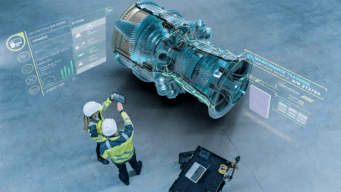The upstream oil and gas industries have traditionally been slow to adopt new technologies. Anything new has to be proven in the field before most companies will adopt it. The development of Artificial Intelligence (AI) and advanced analytics should be different. For oil and gas, this combination offers the ability to continuously increase operational performance and improve decision-making to minimize risk and failure. The key is the ability of AI and analytics to release the value of data locked in content.
Big Data analytics has been a hot topic within oil and gas for a number of years. Little surprise. The industry has been producing Big Data for years. With advances in technology such as seismic software, geophones, logging tools and sensors, every well produces a massive amount of data every day. It’s probably fair to say that upstream oil and gas exploration produces more data than any other industry in the world.
More data, less insight
We’ve also known for years that the value in that data lies in how it can be interpreted – with the correct context and association from inside and outside the organization applied to it. Better decision-making is imperative, especially in challenging market conditions. Companies take huge risks to find, drill, complete and produce oil and gas. The speed and quality at which decisions can be reached and executed really does distinguish success from failure.
Analytics is the answer. This could be anything from descriptive and diagnostic analytics that improve operational efficiencies and optimize uptime to what OpenText terms ‘AI-enhanced analytics,’ which automates simple decisions while providing a set of potential outcomes to the user, helping to make much faster and more accurate decisions.
The results of properly applying analytics are impressive. Bain & Co suggests that analytics can help oil and gas companies improve production by 6% to 8%. To put that in monetary terms, McKinsey estimates that it can improve production efficiency ‘by ten percentage points to yield up to $220 million to $260 million bottom-line impact on a single brownfield asset’. Yet, Bain points out that only about 4% of companies across industries have the capabilities to use advanced data analytics to deliver tangible business value. In fact, research from GE found that less than 1% of all data collected by oil and gas companies is used for decision-making.
The industry has invested in analytics but it is yet to get anywhere near to delivering on its full potential. There are two major reasons for this:
Narrow operational focus
First, oil and gas producers are producing more detailed data in real time at lower costs and from previously inaccessible areas – and then failing to realize its full value. Most petroleum companies have focused their analytics activities on driving functional excellence.
This data has improved a well or site but there is rarely enterprise integration. Instead the companies have developed legacy systems that contain disparate data sets – effectively silo-ing the information, making it difficult to collect and analyze. Adding large volumes of real-time, unstructured data from sensors multiplies the challenge of getting to the value in data.
Each function may have lakes of data, but unless the analytics solution can bring it all together and create a ‘single version of the truth’ delivered to the right people at the right time, it is difficult to improve performance. If the industry is to move from observational performance monitoring to continuous improvement through advanced analytics, it requires the ability to draw quickly on a wide range of data sets drawn from outside the particular production system or functional area and, in some instances, from beyond the organization.
For example, an organization may be very good at capturing and analyzing data from a single well but it’s almost certainly not comparing that site with its other properties worldwide. However, oil and gas companies can be using the real-time data captured on sites to make much better decisions on where to drill, how to improve production uptime and how to optimize production individually and across the enterprise.
The majority of data is inaccessible
Secondly, while a great deal of focus on Big Data has covered the volume and velocity, it’s actually the variety of data that poses a greater challenge. There is a huge diversity of data in the enterprise and much of it is currently locked in content. Like most organizations, many of the most significant business processes are document-centric – completion design or production maintenance, for example. It’s clear that an analytics solution that can connect key documents, ERP systems, real-time production data and capital projects provides increased visibility to boost insight and improve decision-making.
Unlocking the data in content should become a core part of an analytics solution for oil and gas. Gartner estimates that, in the next few years, 20% of all business content will be authored by machines, and machine-generated, dynamic metadata will be integral to discovering 50% of new digital business revenue streams. As content grows in importance, organizations will increasingly struggle to perform effective analysis on structured and unstructured content where legacy content is hard to find and access and current analytics tools are limited to structured data.
Data from sensors can tell you how a piece of machinery is working but it can’t help with the bigger picture unless it is part of an integration of data sets. Take the example of well site development. It takes hundreds of vendors and suppliers to locate, drill, complete, and produce oil and gas fields. The energy industry is built on these supply chain relationships and value is gained for how well the oil and gas companies can achieve efficiency gains through service provider cost reductions. To identify and execute performance and quality improvements, the contractual, engineering and maintenance documents need to be related to operational and production data.
AI and analytics: Unlocking the value in content
AI – encompassing machine learning – enables a level of analytics that can quickly identify the important information in the vast volume of data created and provide accurate guidance on key decisions. It also has the potential to uncover transformative insights in all content held across the enterprise. It can take the data within content and analyze it in conjunction with data from other structured and unstructured sources.
By applying AI-enhanced analytics, organizations can automate the process of collecting, cleansing and classifying content so it is available across the enterprise. It releases the value in the knowledge that has been previously lost in poor document-centric processes. It merges this knowledge with other data sources to identify where business and productivity improvements can be made
An AI-led approach to analytics can help the oil and gas industry in a wide range of business areas:
- Minimize the risk and increase speed to production in well site development
- Improve well site development and divestment strategies
- Improve operational performance while reducing costs
- Improve health & safety and environmental performance
- Introduce preventive maintenance to ensure optimum uptime
- Improve collaboration and performance within the oil and gas value chain
- Improve the speed and quickly of both operational and business-level decision-making
AI-enhanced analytics: the beginning of the journey
Today, few oil and gas companies have begun to exploit the potential of AI and analytics. However, AI-enhanced analytics solutions – such as OpenText™ Magellan – are now mature and offer companies the ability to harness all their data and content to improve decision-making.
Companies that can tame Big Data through combining business and engineering documentation with back-office ERP data, seismic data and sensor data will be an extraordinarily strong position to maximize existing operations while improving their agility to seize new opportunities and revenue streams.




